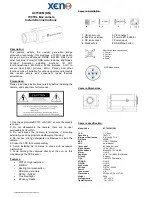
version 1.5 rev 4 Dec 2019
32
Sona &
Marana
camcorders were the image readout rate was not fast enough to keep up with a panned image. In modern sCMOS
cameras however, the readout speeds are so high that rolling shutter is most suited for the majority of scientific
applications. Some sCMOS cameras such as Neo and Zyla 5.5 can operate in a mode called
Global Shutter
as well
as Rolling Shutter. Global Shutter which can be thought of as a “snapshot” as all pixels of the array are exposed
simultaneously. This avoids spatial distortion, however frame rates are reduced and noise is higher when compared to
operation in Rolling Shutter mode.
4.7.1 R
olling
s
HUtteR
M
ecHanisM
In Rolling Shutter mode, charge transfer happens on a per row basis whilst in global shutter charge transfer happens for
the whole sensor or globally. To read out a pixel in Rolling Shutter mode, the following occurs within the analog circuitry:
1. The read out node is reset
2. The node level (reference level) is sampled
3. Charge is transferred from photodiode to node
4. The node level (signal level) is sampled
5. Reference level (step 2) is subtracted from signal level (Step 4) to get real signal
This process is commonly referred to as CDS (Correlated Double Sampling) and is done in the analog domain before
digitization. The reason it is required is due to what is known as reset noise, this arises because every time the node is
reset it does not settle at exactly the same level and hence the actual level must be measured (Step 2) and subtracted
from the signal level (Step 4) to get the real signal.
4.7.2 s
ignal
i
nfoRMation
The Rolling Shutter signals in the diagrams are as follows:
•
FIRE
: (Exposure for Row 1): In Rolling Shutter mode, the FIRE output from the camera indicates to the user the
exposure time for the first row
•
FIRE Row n
: (Exposure for Row n): The exposure for Row 2 is delayed by one row time relative to Row 1,
Row 3 is delayed by one row time relative to Row 2, etc. for all rows in the frame (up to Row n). This signal is
connected to an external output from the camera known as FIRE Row n.
•
FIRE ALL
: The Fire ALL output from the camera indicates when all rows within a frame are being
simultaneously exposed.
•
FIRE ANY
: The FIRE ANY output indicates when any row within a frame is being exposed.
•
ARM
: The ARM output from the camera is used in external and software triggering modes to indicate when the
camera is ready to accept an incoming trigger. If ARM is low when a trigger event occurs, it will be ignored
•
Frame Readout Phase
: This signal shows the period during which the signal frame is read out from the sensor
•
*
: Marks the start of an exposure.
•
*
: Marks the end of exposure.
Throughout this section exposure times are referred to as either “Short” or “Long”.
Short
refers to when the required exposure time is less than the time it takes to read out a frame.
Long
refers to when the required exposure time is greater than the time it takes to read out a frame.
















































